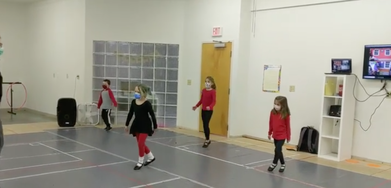 Click the image to see some stellar timing from some of our SRL dancers! Click the image to see some stellar timing from some of our SRL dancers! Last time we did a technique review, we covered rhythm. So you may be asking yourself…isn’t timing the same thing? While the two are definitely related, not quite! While rhythm refers to a dancer’s synchronization with the music, timing refers to the pace at which a dancer performs individual movements. Or, to say it another way: rhythm is how the pattern of movements correlates to the music’s pattern, while timing is the relationship of one movement to another. You can think of it as pacing too…but it’s a brain-twister! The truth is, it’s hard to separate timing and rhythm, and issues with one will generally cause issues with the other. Going back to the “Happy Birthday” analogy from last time—someone with rhythm issues won’t be able to stay on beat with everyone singing, while someone with timing issues may extend one word too long and then maybe speed up singing another part of the song. In Irish dance, especially in the more advanced levels, individual movements have individual timings (think of a sliding movement in a hornpipe dance versus fast-flying feet in a slip jig) and while keeping to the beat (rhythm) is one struggle, timing those individual movements is another. Essentially, one move may be meant to take two beats of the music but the dancer does it in one or three. There’s two separate kinds of timing issues on a basic level: too fast or too slow. While too slow is probably easiest to see with the naked, non-dancer eye (as it skips over too many beats in between or during movements)—too fast is equally common and might manifest itself with a dancer finishing a phrase (i.e. a set of movements) and then needing to pause to begin the next phrase. Sometimes timing issues stem from nervousness or difficulties with a particular move or phrase, and sometimes it’s an inability to hear the music. Dealing with timing issues, like rhythm, needs to be looked at on an individual basis, but there are a few things you can help with at home! First off, if it’s an individual movement issue, YouTube is your best friend! Look for a video of the move done correctly, then slowed down and explained, and then put to music that your dancer will be able to watch over and over again outside of the classroom setting. Sites like Target Training Dance or Irish Dance Magazine’s YouTube are amazing resources—Irish dance may be a small world, but it’s a supportive one, and there’s a dearth of information out there! When trying to figure out how multiple movements fit together (like when you learn a new step), we always recommend that dancers record a video of it slowed down with no music as well as a video with the step danced to music. Back in the day, we used tape recorders of our teachers singing or lilting steps before cameras were built into every phone!  Timing is emphasized from day one, as solid timing is one of the easiest ways to move up competitive levels—click the image to see a Beginner class learning to time their movements! Timing is emphasized from day one, as solid timing is one of the easiest ways to move up competitive levels—click the image to see a Beginner class learning to time their movements! It may also be the type of music that’s the issue—perhaps it’s specific instruments (some dancers can hear a fiddle, but not the downbeat from an accordion, for example) that cause confusion or a music with a particular beat (to review the differences in Irish dance music, check out this past post!) This problem has the same suggestions for home practice as rhythm issues (see that post from last week here)—see if your dancer is able to clap along to the beat of the music. If they’re not able to hear the music they won’t be able to feel the music while they dance, which will throw off the timing of their moves. Musicality is a learned skill for many dancers and the biggest key for improvement? Consistent practice, determination, and possibly a private lesson or two for good measure (as small as SRL classes are, sometimes a little one-on-one time is needed to better suit one dancer’s particular learning style or better determine where the disconnect is.) At home, they can try dancing to the beat of a metronome or simplified beats (stripping back the music to simply beat will make is easier to hear!) You can also try singing steps alongside the music or using your hands to keep time to the music on the floor to help your dancer visualize the beat—every kid learns differently! The important part is to not give up, and ask your dancer’s instructors for help as needed! This post is part of a series. Read our last technique review, all about rhythm, here. Check out the blog every Monday and Thursday for more posts about Irish history, dance culture, community news, and spotlights on our dancers, staff, and families—among other fun projects! And don’t forget to dance along with us on both Facebook and Instagram.
0 Comments
Your comment will be posted after it is approved.
Leave a Reply. |
SRL NewsFind all of our latest news on our Scoil Rince Luimni Facebook page! Categories
All
Archives
August 2022
|

 RSS Feed
RSS Feed